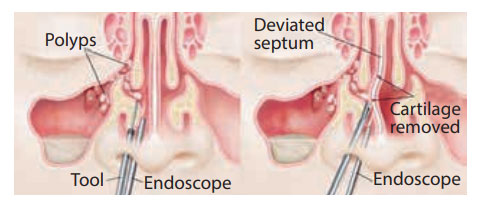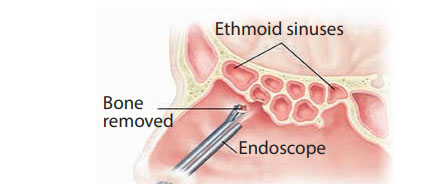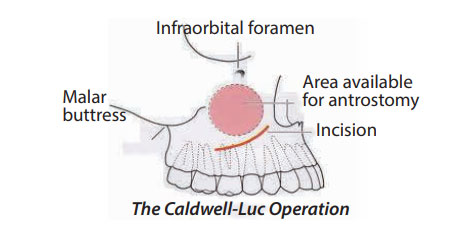WHAT ARE SINUSE?
Sinuses are air-filled cavities in the bones of the face and head. They are connected to the inside of the nose through small openings called ostia. There are four groups of sinuses: frontal (in the forehead), ethmoid (between the eyes), maxillary (in the cheekbone area) and sphenoid sinuses (in the middle of the head, behind the eyes).
They assist the control of the temperature and humidity of the air reaching the lungs, regardless of how cold, hot or dry the weather is. They naturally produce mucus and if this is unable to drain from the sinuses it can becomes infected causing sinusitis.
WHAT IS SINUSITIS?
Sinusitis is caused by blocked, inflamed or infected sinuses. Patients will often complain of a blocked nose, pressure or congestion in the face, runny nose or mucus problems. Other symptoms include headache and loss of sense of smell. Sinusitis can be difficult to diagnose and your specialist will want to examine your nose with a small endoscope in order to help find out what is wrong. Often a CT scan of your sinuses is necessary. Most patients with sinusitis get better without treatment or respond to treatment with antibiotics, nose drops, sprays or tablets. In a very small number of patients with severe or chronic sinusitis an operation may be needed.
WHAT IS ENDOSCOPIC SINUS SURGERY?
Endoscopic sinus surgery (also called Functional Endoscopic Sinus Surgery or FESS) is the name given to operations for sinus problems for people with chronic or severe sinus infections. Endoscopic sinus surgery is done from inside the nose and avoids external cuts. Sinus surgery aims to unblock the ostia (the small holes that connect the sinuses to the nose) of the sinuses to drain your sinuses, relieving your discomfort and preventing infection.
HOW IS THE OPERATION DONE?
Usually the operation is done with you asleep under general anaesthesia but it may also be done in some cases with just your nose anaesthetised (local anaesthesia). The operation is all done inside your nose.
The surgeon uses a thin, lighted tube (endoscope) that is put into your nose. Your doctor can see the images on a monitor. The diseased sinuses are identified and are opened up using special instruments. If there are any polyps in the nose they are removed. The natural pathways of mucus drainage are enlarged to prevent blockage and the diseased lining (mucosa) is removed. The operation takes about two hours depending on the extent of the disease that must be treated.
Septoplasty: sometimes the doctor may need to straighten the partition wall inside the nose to get access to your sinuses. This is called septoplasty, and will add an extra hour to the procedure.

Opening the ethmoid sinuses: the ethmoid sinuses are made up of many small air spaces, like a honeycomb. Like the other sinuses, the ethmoids have a lining that makes mucus. In some cases the drainage path is blocked. The doctor may open the thin walls of bone that separate the air spaces. This creates a passage for mucus to drain more easily.

AFTER YOUR OPERATION
- Packs and splints: we may need to put a dressing in each side of your nose to prevent bleeding. The dressings are called “packs” and they will block your nose up so that you have to breathe through your mouth. They will be removed before you are discharged. This may be a little uncomfortable and you may get a little bit of bleeding which will usually settle quickly.
- Does it hurt? It is common for your nose to be quite blocked and to have some discomfort for a few weeks after the operation. You may also get some blood-coloured watery fluid from your nose for the first two weeks – this is normal.
- Will I have to stay in hospital? You should expect to stay in hospital for a day or overnight and will need to rest at home for two weeks afterwards.
- Will I have to come back? Your doctors’ will usually see you in the outpatient department two to four weeks after your surgery to assess the effect of your surgery.
AFTER YOU LEAVE HOSPITAL
- Blow your nose gently for the first week or it might start bleeding.
- You may be given nasal drops, spray or douches to help clear your nose.
- If you are going to sneeze, sneeze with your mouth open to protect your nose.
- You may get some blood coloured watery fluid from your nose for the first two weeks or so, this is normal.
- Your nose will be blocked both sides like a heavy cold for 10 to 14 days after the operation and you may get a dry mouth, take sips of water regularly to help with this.
- Try to stay away from dusty or smoky places.
- You should not play sports for about one month after the operation.
- Avoid all moderate and heavy lifting for about ten days after the operation.
ARE THERE ANY COMPLICATIONS OR RISKS TO THIS SURGERY?
There are some risks that you must be aware of before giving consent to this treatment. These potential complications are rare. You should discuss with your surgeon about the likelihood of problems in your case.
- Some spotting of blood is normal but a severe nosebleed may occur within 12 days of the operation. This only occurs in 1 in 100 patients.
- About 1 in 100 patients may develop an infection of the sinuses and may require antibiotic treatment.
- The sinuses are very close to the wall of the eye. Sometimes damage to the eye can be caused by bleeding around the eye. Very rarely another operation may be needed to stop the bleeding. The chances of this happening are very low, about 1 in 1000.
- Tear duct injury with tearing of the eye can occasionally occur and may be ongoing.
- The muscles that turn the eye can sometimes be damaged but again very rarely. An eye doctor may be needed, if you have double vision.
- The sinuses are very close to the thin bone at the base of the brain. All sinus operations carry a small risk of leakage of fluid from the space around the brain. If this rare complication happens, you will have to stay in hospital until the leak stops. Sometimes another operation is needed to stop the leak.
- Decreased sense of smell can occur following nasal and sinus surgery, however the sense of smell usually improves over time.
- Altered sense of taste can rarely occur
CALDWELL-LUC OPERATION
It may happen that endoscopic sinus surgery cannot achieve complete drainage, removal of its diseased lining or of the polyps in the sinus. In such a circumstance your surgeon may decide that opening the sinus through your jaw is necessary. This procedure is named Caldwell-Luc Operation (intra-oral antrostomy), it involves making a small cut between the upper lip and gum and removing a tiny piece of bone from the anterior wall of the maxillary sinus.
Though the Caldwell-Luc procedure is safe some complications can occur such facial swelling, pain and/or numbness of the face and pain and/or numbness of the teeth/gums, rarely an injury to the nerve that provides sensation to the cheek, upper lip and teeth can occur.




